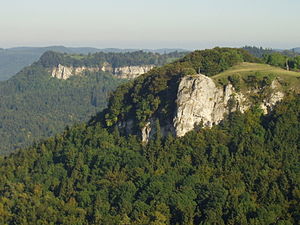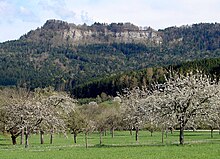Punch (Swabian Alb)
| Punch | ||
|---|---|---|
|
in front Lochenstein, behind Lochenhörnle |
||
| height | 963.6 m above sea level NHN | |
| location | Baden-Wuerttemberg , Germany | |
| Mountains | Swabian Alb | |
| Coordinates | 48 ° 13 '10 " N , 8 ° 50' 57" E | |
|
|
||
| rock | White Jura | |
| Normal way | To be reached via Weilstetten | |
| particularities | Lochenpass and Lochenstein viewpoint | |
The Lochen is a mountain in the southwestern Swabian Alb , which forms a section of the Albtrauf above the Balingen district of Weilstetten . The two most prominent points are the Lochenstein ( 963.6 m above sea level ) and the eastern Lochenhörnle ( 952.8 m above sea level ), usually just referred to as the Hörnle . "' Die Lochen ' is the name of the upper, steep eaves side between Schafberg and Hörnle." The name Die Lochen , like the older name of the neighboring Plettenberg - Die Plaikten , is feminine. The mountain group is located in the districts of the municipalities of Hausen am Tann (Lochenstein) and Meßstetten , Tieringen (Lochenhörnle).
geography
The Lochenstein, one of the most impressive viewpoints in the Alb, can be reached from the “Gründle” on the Lochenpass on the 440 road from Balingen towards Lake Constance in 20 minutes with a little effort. On the east side of its high plateau is a refuge of the Swabian Alb Association . It's locked. The key can be borrowed. A family holiday village and a youth hostel are not far from the Lochenstein .
From the Lochenstein, both the Swabian-Alb-Nordrand-Weg and the Main-Neckar-Rhein-Weg lead on to Schafberg and Plettenberg .
The promontory of the Hörnle, located approx. 2 kilometers to the east, juts out from the Alb plateau as an acute angle. It separates the steep drop of the northern edge of the Alb (Albtrauf) from the mountain flank of the Eyach valley , which ends here . The southern slope of the Hörnle forms the end of the Upper Schischem valley . At an altitude of 860 m above sea level. NHN rises here from the stealthy in a contained source.
The state road 440 to the Lochenpass ( 890 m ) from the direction of Balingen is a popular route for motorcyclists. The driveway coming from Weilstetten is closed to motorcycles on weekends and public holidays in the summer months.
A special feature of a mountain in the Swabian Alb is the summit cross on an exposed rock with good visibility, a custom that is otherwise more likely to be found in alpine regions.
history
The Lochen plateau was the site of prehistoric hilltop settlements. In its geological nature as a free-standing limestone block in the landscape, it offered excellent defensive possibilities, and the summit plateau allowed for convenient settlement. Well-founded archaeological excavations were carried out by Oscar Fraas in 1830 and Gerhard Bersu and Peter Goessler in 1923 .
Some settlement finds date from the Neolithic and Middle Bronze Ages . There was a first high point of settlement in the late Bronze Age ( urn field culture of the 10th / 9th century BC), a second in the early Iron Age ( Hallstatt culture of the 7th / 6th century BC) and the La Tène period (300 BC) Christ). It has not yet been clarified whether the Celtic settlement of the La Tène period seamlessly follows the Hallstatt culture or represents a third significant settlement impulse. Settlement ends around 400 BC.
Individual finds date from the time when the Lochen belonged to the Roman Empire (2nd / 3rd century AD). They come from the Roman culture. On the other hand, there are individual finds from the time of the Great Migration (4th century AD).
More finds come from the Merovingian period (5th to 7th centuries). During the Peasants' War on February 28, 1525, an army encamped on the Lochen. In 1945 the settlement ended when the Lochenhof was blown up by withdrawing SS troops. The water source was restored by the Albverein . After the historical Messstetter Brunnenstube located 910 meters above sea level, it is one of the highest springs in the Swabian Alb.
Flora
The plateau of the Lochen with the limestone cliffs and slopes is the location of numerous rare plants. Mosses of sun-exposed rocks that can withstand heat and drought , the placodium saxicolum and the black bowl lichen of the Jura with the characteristic species name Lecidea jurana and the lead lichen ( Ochrolechia pallescens ) cover the rocks. In addition to postglacial relics such as the grape saxifrage ( Saxifraga paniculata ), the alpine eyelid ( Athamanta cretensis var.mutellionoides ) is mainly found on the rock that bears the summit cross, as a representative of post-warmer relics that have survived as floral relics for millennia the slope edges and upper slopes with fringing vegetation and the semi- arid and limestone grasslands, as well as on the actual rocks. Unfortunately, earlier plants on the plateau such as the mountain cockerel ( Anemone narcissiflora ), corymbosum ( Chrysanthemum corymbosum ) and the Austrian rock mustard ( Sisymbrium pyrenaicum subsp. Austriacum ) such as the Apollo butterfly ( Parnassius apollo ) have passed away. In the long term by botanists as houseleek ( Sempervivum tectorum ) named Houseleeks the punching is it based on current knowledge about Sempervivum globiferum subsp. globiferum , a species of plant that belongs to the Jovibarba plant group. As elsewhere on the Balinger Alb, in contrast to the eaves forests ( calcareous beech forest ) of the Swabian Alb , which are usually full of red beeches ( Fagus silvatica ), here mainly maple - ash - elm forest ( Acer-Fraxinus-Ulmus ), with remarkably old, White firs ( Abies alba ) over 50 m high and spruce ( Picea excelsa ) naturally occurring here .
Protection status
The Lochen is part of the Schafberg -Lochenstein nature reserve , which covers 102 hectares. This is embedded in the " Großer Heuberg " landscape protection area and was designated in 1987 because of its beauty and its quality as a refuge for rare plants and animals. The forest areas in the higher areas must be protected in order to preserve diversity. The western part of the striking lookout rock with the summit cross has not been allowed to be entered since the beginning of 2017 for reasons of species protection in order to protect the eye root that still occurs there . The eastern part of the rock is still accessible.
Web links
Individual evidence
- ↑ Map services of the Federal Agency for Nature Conservation ( information )
- ^ The district of Balingen - Official district description . In: Statistisches Landesamt Baden-Württemberg in connection with the district of Balingen (ed.): The city and districts in Baden-Württemberg . tape 1 , 1960, p. 50 .
- ^ The district of Balingen - Official district description . In: Statistisches Landesamt Baden-Württemberg in connection with the district of Balingen (ed.): The city and districts in Baden-Württemberg . tape 2 , 1961, p. 415 .
- ↑ G. Bersu, P. Goessler: The Lochenstein near Balingen. Fundber. Schwaben NF 2, 1922-24, 73-103, cf. also the remarks on the hill settlements of the Lochen in Manuel Werner: The "Sprout Donarsbart Sempervivum hirtum §soboliferum am Lochen (Swabian Alb)", in: - ( Memento of the original from March 9, 2009 in the Internet Archive ) Info: The archive link became automatic used and not yet tested. Please check the original and archive link according to the instructions and then remove this notice. . The paragraph mark serves here only as a provisional nomenclature subdivision, currently this plant is botanically known as Sempervivum globiferum subsp. globiferum referred
- ↑ Scherrer: Peasant War:. In: Heimatkundliche Blätter Balingen , February 1975, No. 2 ( Memento of the original from March 4, 2016 in the Internet Archive ) Info: The archive link was inserted automatically and has not yet been checked. Please check the original and archive link according to the instructions and then remove this notice. , P. F., Here p.
- ↑ (Fritz Scheerer): [1] In: Heimatkundliche Blätter Balingen from January 31, 1985. P. 484.
- ↑ (Hannes Mohr): [2] In: Zollern-Alb-Kurier of September 21, 2011.
- ↑ For the first time correctly as the son Ender Donarsbart the group Jovibarba determined: Manuel Werner: The "sprout end Donarsbart" Sempervivum hirtum soboliferum on Lochen (Swabian Alb) in: - ( Memento of the original March 9, 2009 at the Internet Archive ) Info: The archive link was used automatically and not yet checked. Please check the original and archive link according to the instructions and then remove this notice. , more up-to-date information on this in Manuel Werner: The "common fringed house root" on the Lochenstein ( Sempervivum globiferum subsp. globiferum , syn. Jovibarba globifera subsp. globifera ) http://hauswurz.jimdo.com/selected-standorte/schwäbische-alb/sempervivum- globiferum /
- ↑ M. Werner: The "Sprossende Donarsbart" Sempervivum hirtum §soboliferum am Lochen (Swabian Alb), in: - ( Memento of the original from March 9, 2009 in the Internet Archive ) Info: The archive link was inserted automatically and not yet checked. Please check the original and archive link according to the instructions and then remove this notice.
- ↑ : Punch Rocks . In: Schwarzwälder Bote , January 5, 2017.







